SpringBoot数据库操作¶
1.JDBC+HikariDataSource¶
在SpringBoot 2.x项目中,默认使用Hikari连接池管理数据源。相比于传统的 C3P0 、DBCP、Tomcat jdbc 等连接池更加优秀。
当项目pom.xml引入spring-boot-starter-jdbc启动器依赖后,即可自动导入Hikari,该启动器不但依赖它,还会对其自动配置并创建数据源。我们以MySQL数据库为例,介绍如何使用Hikari。
1.1应用实例¶
演示SpringBoot如何通过 JDBC+HikariDataSource 完成对Mysql操作。
(1)数据库和表
-- 创建数据库
DROP DATABASE IF EXISTS spring_boot;
CREATE DATABASE spring_boot;
USE spring_boot;
-- 创建表
CREATE TABLE furn(
`id` INT(11) PRIMARY KEY AUTO_INCREMENT, #id
`name` VARCHAR(64) NOT NULL, #家居名
`maker` VARCHAR(64) NOT NULL, #厂商
`price` DECIMAL(11,2) NOT NULL, #价格
`sales` INT(11) NOT NULL, #销量
`stock` INT(11) NOT NULL, #库存
`img_path` VARCHAR(256) NOT NULL #照片路径
);
-- 初始化家居数据
INSERT INTO furn(`id` , `name` , `maker` , `price` , `sales` , `stock` , `img_path`)
VALUES(NULL , '北欧风格小桌子' , '熊猫家居' , 180 , 666 , 7 , 'assets/images/product-image/6.jpg');
INSERT INTO furn(`id` , `name` , `maker` , `price` , `sales` , `stock` , `img_path`)
VALUES(NULL , '简约风格小椅子' , '熊猫家居' , 180 , 666 , 7 , 'assets/images/product-image/4.jpg');
INSERT INTO furn(`id` , `name` , `maker` , `price` , `sales` , `stock` , `img_path`)
VALUES(NULL , '典雅风格小台灯' , '蚂蚁家居' , 180 , 666 , 7 , 'assets/images/product-image/14.jpg');
INSERT INTO furn(`id` , `name` , `maker` , `price` , `sales` , `stock` , `img_path`)
VALUES(NULL , '温馨风格盆景架' , '蚂蚁家居' , 180 , 666 , 7 , 'assets/images/product-image/16.jpg');
SELECT * FROM furn;

(2)进行数据库开发,首先要在pom.xml文件中引入spring-boot-starter-data-jdbc。SpringBoot不知道项目要操作Mysql还是Oracle,因此还需要导入数据库驱动,并指定对应版本。
<!--进行数据库开发,引入data-jdbc starter-->
<dependency>
<groupId>org.springframework.boot</groupId>
<artifactId>spring-boot-starter-data-jdbc</artifactId>
</dependency>
<!--导入mysql驱动,如果使用版本仲裁,SpringBoot默认的版本为8.0.26-->
<dependency>
<groupId>mysql</groupId>
<artifactId>mysql-connector-java</artifactId>
<version>5.1.49</version>
</dependency>

(3)在application.yml配置操作数据源的信息
spring:
datasource: #配置数据源
#说明:如果没有配置useSSL=true,启动项目会报红警告,但不影响使用
url: jdbc:mysql://localhost:3306/spring_boot?useSSL=true&useUnicode=true&characterEncoding=UTF-8
username: root
password: 123456
driver-class-name: com.mysql.jdbc.Driver
(4)创建Javabean--Furn.java
package com.li.thymeleaf.bean;
import lombok.AllArgsConstructor;
import lombok.Data;
import lombok.NoArgsConstructor;
import java.math.BigDecimal;
/**
* @author 李
* @version 1.0
*/
@Data
@NoArgsConstructor
@AllArgsConstructor
public class Furn {
private Integer id;
private String name;
private String maker;
private BigDecimal price;
private Integer sales;
private Integer stock;
private String imgPath;
}
(5)测试类ApplicationTests.java
package com.li.thymeleaf;
import com.li.thymeleaf.bean.Furn;
import org.junit.jupiter.api.Test;
import org.springframework.boot.test.context.SpringBootTest;
import org.springframework.jdbc.core.BeanPropertyRowMapper;
import org.springframework.jdbc.core.JdbcTemplate;
import javax.annotation.Resource;
import java.util.List;
/**
* @author 李
* @version 1.0
* 演示如何在SpringBoot中开发测试类
*/
@SpringBootTest
public class ApplicationTests {
//这里使用spring的JDBCTemplate
@Resource
private JdbcTemplate jdbcTemplate;
@Test
public void contextLoads() {
//使用RowMapper接口来对返回的数据进行封装(底层是反射->setter)
BeanPropertyRowMapper<Furn> rowMapper =
new BeanPropertyRowMapper<>(Furn.class);
List<Furn> furns = jdbcTemplate.query("select * from furn", rowMapper);
for (Furn furn : furns) {
System.out.println("furn=" + furn);
}
//查看底层使用的是什么数据源
System.out.println(jdbcTemplate.getDataSource().getClass());
}
}
测试结果:

<!--要开发SpringBoot测试类,需要引入test starter--> <dependency> <groupId>org.springframework.boot</groupId> <artifactId>spring-boot-starter-test</artifactId> </dependency>
2.整合Druid到SpringBoot¶
2.1Druid介绍¶
Druid数据库连接池性能优秀,它除了提供性能卓越的数据池功能外,还继承了SQL监控,黑名单拦截等功能。强大的监控特性,通过Druid提供的监控功能,可以清楚知道连接池和SQL的工作情况,所以根据项目需要,我们也要掌握Druid和SpringBoot的整合。
整合Druid到SpringBoot的方式:
- 自定义方式
- 引入starter
2.2Druid基本使用¶
(1)修改pom.xml,引入druid依赖
<!--引入druid依赖-->
<dependency>
<groupId>com.alibaba</groupId>
<artifactId>druid</artifactId>
<version>1.1.17</version>
</dependency>
(2)创建配置类 DruidDataSourceConfig.java,将DruidDataSource注入容器
package com.li.thymeleaf.config;
import com.alibaba.druid.pool.DruidDataSource;
import org.springframework.boot.context.properties.ConfigurationProperties;
import org.springframework.context.annotation.Bean;
import org.springframework.context.annotation.Configuration;
import javax.sql.DataSource;
/**
* @author 李
* @version 1.0
* 配置类
*/
@Configuration
public class DruidDataSourceConfig {
//注入DruidDataSource
//通过@ConfigurationProperties指定读取application.yml文件的数据
//我们就不需要调用DruidDataSource的setXxx方法来配置(不推荐)
@ConfigurationProperties("spring.datasource")
@Bean
public DataSource dataSource() {
return new DruidDataSource();
}
}
(3)测试类ApplicationTests.java(略,同上)
测试结果:

2.2.1一个问题¶
问题:为什么我们注入了自己的数据源,默认的HikariDataSource就失效了?
先来弄明白,默认的HikariDataSource 是如何配置的:
SpringBoot通过DataSourceAutoConfiguration.java来进行数据源的配置,在进行默认的配置之前,如果检测到容器中已经有DataSource Bean,就不会注入默认的HikariDataSource。
因此,如果你注入了自己的数据源,就不会注入默认的HikariDataSource。
DataSourceAutoConfiguration.java:

2.3Druid监控功能¶
2.3.1开启内置监控页¶
怎样使用Druid的内置监控页面:内置监控页面是一个Servlet,具体配置看这里
(1)在配置类中,启用druid的监控页功能:
在web项目中使用web.xml配置,若在SpringBoot中,有两种方法注入Servlet---注解和RegistrationBean,这里使用RegistrationBean
DruidDataSourceConfig.java:
package com.li.thymeleaf.config;
import com.alibaba.druid.pool.DruidDataSource;
import com.alibaba.druid.support.http.StatViewServlet;
import org.springframework.boot.context.properties.ConfigurationProperties;
import org.springframework.boot.web.servlet.ServletRegistrationBean;
import org.springframework.context.annotation.Bean;
import org.springframework.context.annotation.Configuration;
import javax.sql.DataSource;
/**
* @author 李
* @version 1.0
* 配置类
*/
@Configuration
public class DruidDataSourceConfig {
//注入DruidDataSource
//通过@ConfigurationProperties指定读取yml文件的前缀的数据
@ConfigurationProperties("spring.datasource")
@Bean
public DataSource dataSource() {
return new DruidDataSource();
}
//配置Druid的监控页功能
@Bean
public ServletRegistrationBean statViewServlet() {
//创建StatViewServlet
ServletRegistrationBean<StatViewServlet> registrationBean
= new ServletRegistrationBean<>(new StatViewServlet(), "/druid/*");
//设置初始化参数-用户名和密码-根据官方配置文件设置
registrationBean.addInitParameter("loginUsername", "olien");
registrationBean.addInitParameter("loginPassword", "123456");
return registrationBean;
}
}
(2)启动项目,浏览器中访问http://项目ip:项目端口/项目名称/druid/index.html,输入配置的用户名和密码,即可访问到内置的监控页面:
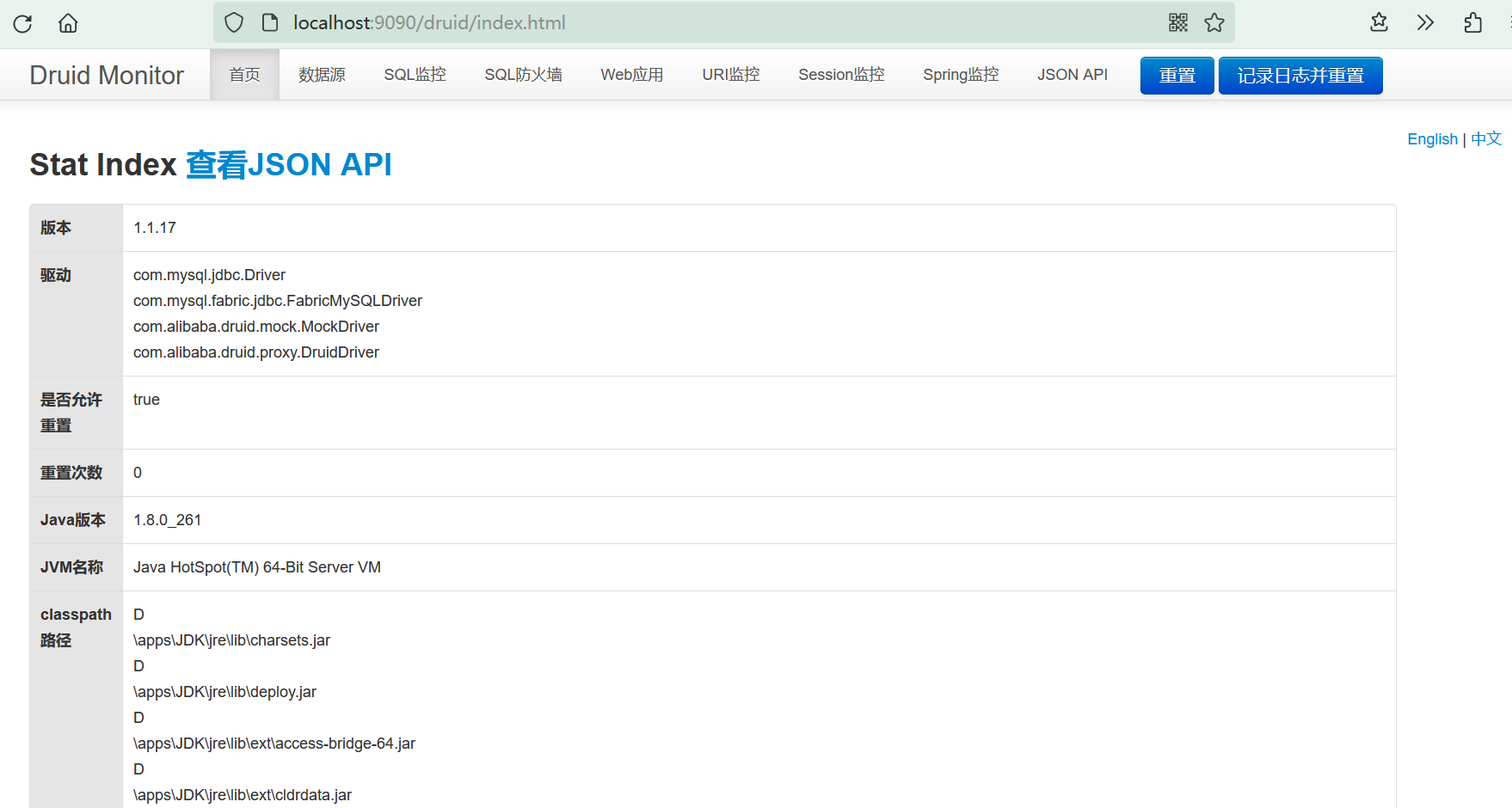
2.3.2SQL监控¶
配置_StatFilter · alibaba/druid Wiki (github.com)
除了文档中的配置方式,也可在配置类中直接对数据源进行设置。
修改DruidDataSourceConfig.java:
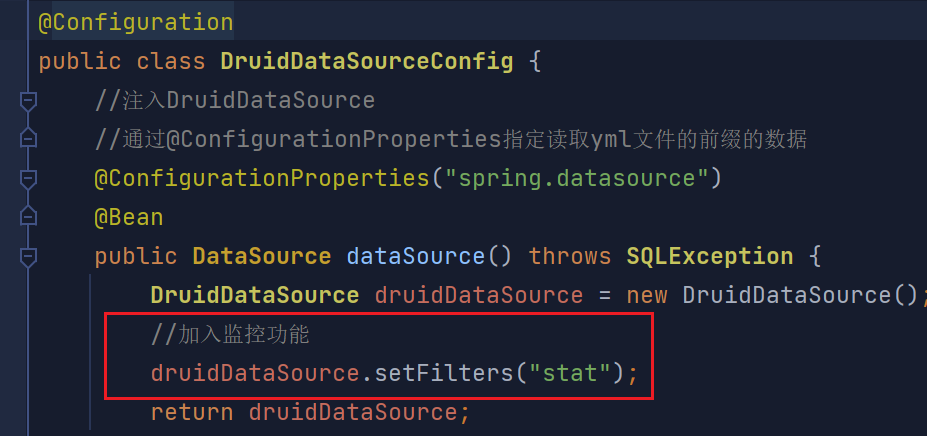
启用SQL监控功能之后,在监控页中可以查看到所有对数据库发出的SQL语句:

2.3.3-Web关联监控¶
修改DruidDataSourceConfig.java:注入webStatFilter
//配置WebStatFilter,用于采集web-jdbc关联的监控数据
@Bean
public FilterRegistrationBean webStatFilter() {
//创建过滤器webStatFilter
WebStatFilter webStatFilter = new WebStatFilter();
FilterRegistrationBean<WebStatFilter> filterRegistrationBean =
new FilterRegistrationBean<>(webStatFilter);
//设置webStatFilter的监控url
filterRegistrationBean.setUrlPatterns(Arrays.asList("/*"));
//根据官方文档设置webStatFilter排除的url
filterRegistrationBean.addInitParameter("exclusions",
"*.js,*.gif,*.jpg,*.png,*.css,*.ico,/druid/*");
return filterRegistrationBean;
}
启用URI监控功能之后,在监控页中可以查看到所有的Web应用情况和URI请求情况:
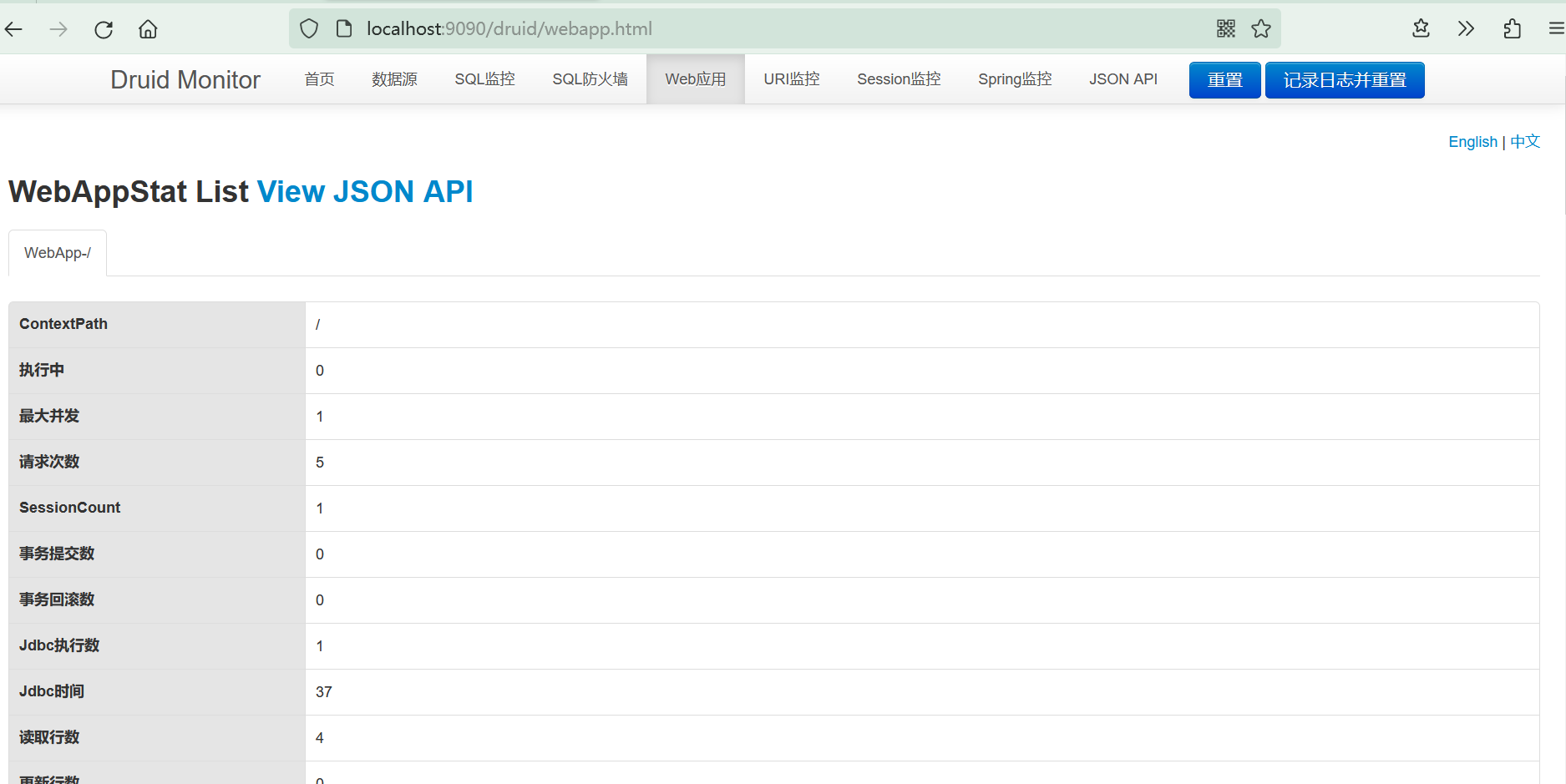

2.3.4SQL防火墙¶
Druid提供了WallFilter,它是基于SQL语义分析来实现防御SQL注入攻击的。具体配置看这里
修改DruidDataSourceConfig.java:
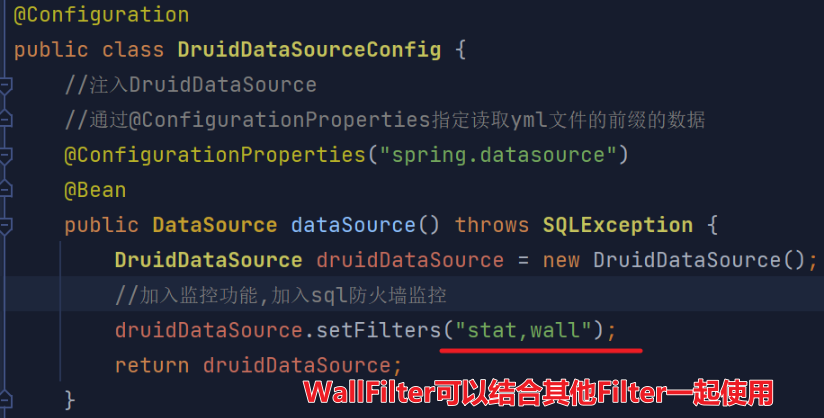
启用SQL防火墙之后,在监控页中可以查看到所有的SQL情况:
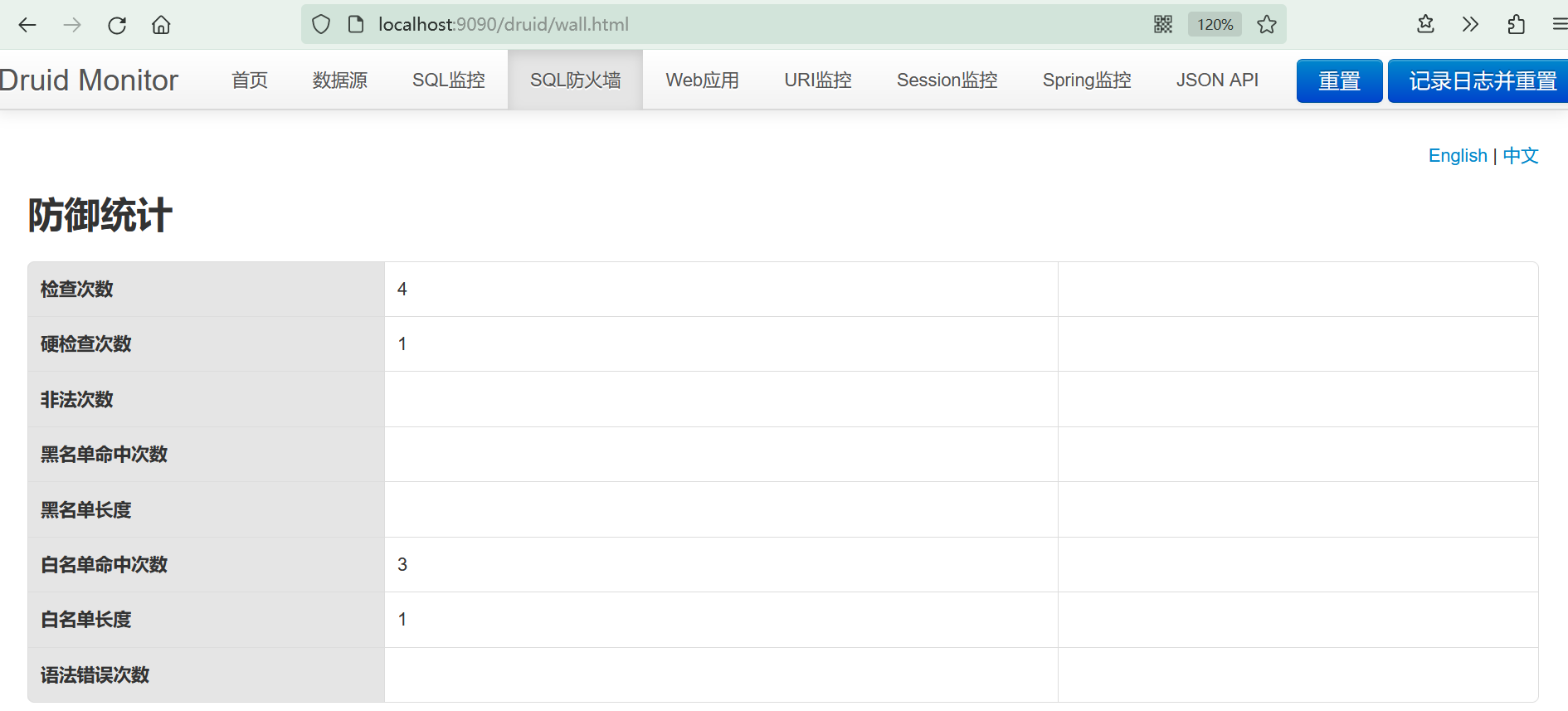

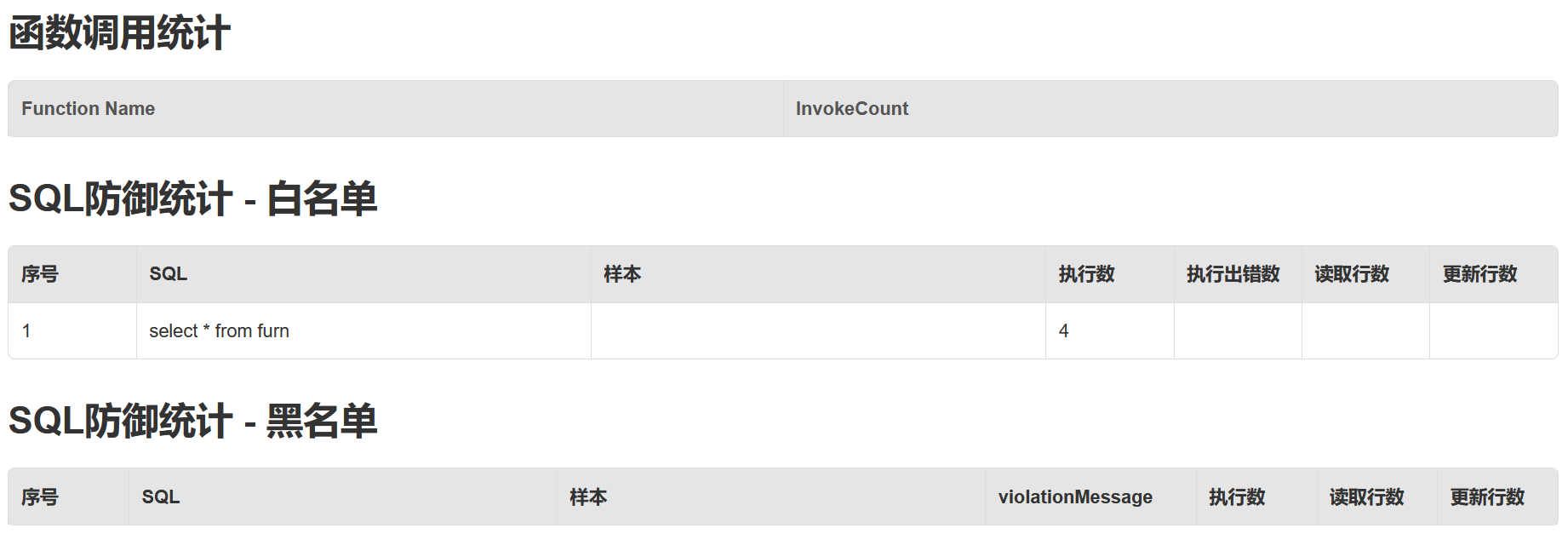
2.3.5Session监控¶
注意:这里的Session不包括Druid后台监控系统产生的Session
Druid的Session监控不需要配置,在开启了内置监控功能后就可以使用了。

2.4Druid-Starter¶
整合Druid到SpringBoot的方式有两种:自定义方式和引入starter。
2.3中的所有例子中我们使用的是自己引入druid+配置类方式整合druid和监控。此外,还可以引入Druid Srping Boot Starter,让程序员在SpringBoot项目中更加轻松集成Druid和监控。
演示使用Druid-Starter(演示之前,删除之前所有的自定义方式操作)
(1)pom.xml引入druid-spring-boot-starter
<!--引入druid的starter-->
<dependency>
<groupId>com.alibaba</groupId>
<artifactId>druid-spring-boot-starter</artifactId>
<version>1.1.17</version>
</dependency>

(2)在application.yml文件中配置druid和监控功能
spring:
datasource: #配置数据源
#如果没有配置useSSL=true,启动项目会报红警告,但不影响使用
url: jdbc:mysql://localhost:3306/spring_boot?useSSL=true&useUnicode=true&characterEncoding=UTF-8
username: root
password: 123456
driver-class-name: com.mysql.jdbc.Driver
#配置druid和监控功能
druid:
stat-view-servlet: #(1)开启监控页
enabled: true
login-username: jack
login-password: 1234
reset-enable: false
web-stat-filter: #(2)启用web监控功能
enabled: true
url-pattern: /*
exclusions: "*.js,*.gif,*.jpg,*.png,*.css,*.ico,/druid/*"
filter:
stat: #(3)启用sql监控功能
slow-sql-millis: 1000 #单位ms
log-slow-sql: true #启用慢查询的sql日志
enabled: true
wall: #(4)启用sql防火墙功能
enabled: true
config:
drop-table-allow: false #是否允许进行删除表的操作
select-all-column-allow: false #是否允许查询所有字段的操作
3.练习¶
将异常处理、注入Servlet、Filter、Listener,Tomcat切换,数据库操作(HikariDataSource&DruidDataSource)相关代码和案例写一遍